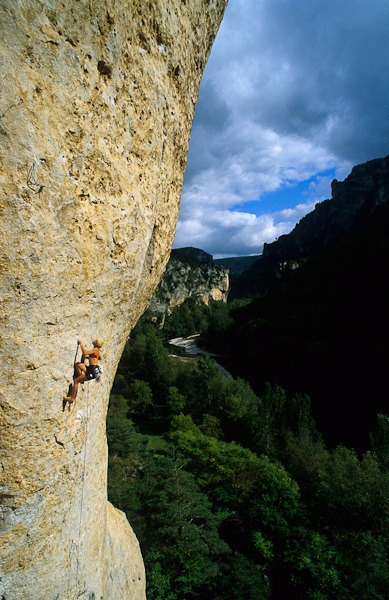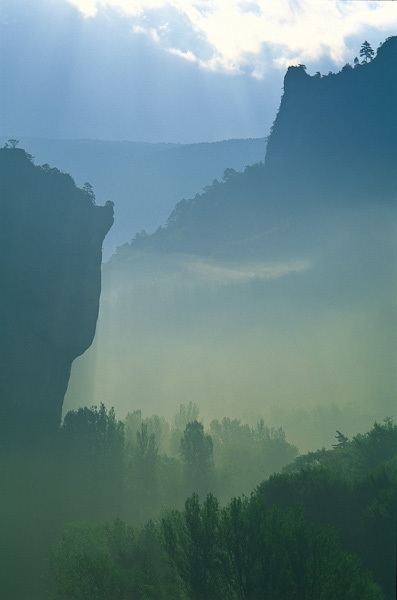Gorges du Tarn, rock climbing in France
Luca Loreggian introduces the beautiful Gorges du Tarn close to Millau in France. 400 routes from 5a to 8c.

 1 / 8
1 / 8
Liv Sansoz climbing at the Gorges du Tarn, France
 Simon Carter
Simon Carter
As we head from Millau towards Le Rozier we drive past farms and fields, then enter the gorges and the road runs parallel to the river Tarn. It twists and turns but the crags don't spring into view and, eyes pinned upwards through the windowpane, we search for those rock faces we'd seen in photos, in magazines and videos, but to no avail: thick vegetation on the one side and the river on the other stop us from detecting anything.
But this is the first impression only, because although the Gorges start immediately after the village Le Rozier, to get a proper glimpse of the crags you need to head on to Les Vignes. It is here that the 70-80m high rock faces suddenly dominate the surroundings.
The rock faces are located on the left-hand side of the river, the walls resemble forts with steep overhangs, gigantic bulges of yellow and orange limestone with the occasional black and blue manganese streaks.
It's practically impossible to get an overall view of the Tarn as the individual sectors are hundreds of meters apart. The atmosphere is uncontaminated, typical of an area still virgin and not particularly popular, at least, to date not amongst climbers. The rock is endless, with 400 routes spread out over five sectors and an enormous potential just waiting to be developed.
The actual climbing and the ambient is unforgettable and we must all thank the likes of Ivan Sorro, Pierre Rouzo, Olivier Obin, Raphael Storbecher and Laurent Triay. They are the ones who have developed the Tarn, in harmony and with respect for the rock and the natural habitat.
The climbing
Worked smooth over the centuries by the elements, the limestone changes considerably from one sector to the next and consequently the style of climbing is extremely varied, from short explosive boulder problems to long stamina plods and highly technical outings. There is something for everyone here but the common denominator is "engagement", commitment for the run-outs: reaching the belays is no mean task (remember to always take an additional quickdraw or locking carabiner as the belays aren't equipped with an abseil carabiner).
Although the routes range from 5a - 8c, this is no easy crag and the majority of the most routes tend to be fairly difficult.
The crags can be reached easily on foot. Park the car in the car parks or the small lay-bys and follow the tracks on the left.
1. Fontaneilles, this is the first crag after Millau as you enter the Tarn valley.
2. Rocher de la Muse, ideal for rainy days
3. Le Gymnaze, 5 sectors. From here onwards you are in the heart of the Gorges du Tarn.
4. Les Baumes Basses
5. Le Cirque des Baumes, the first crag to get the shade
6. L’Entre Deux, this offers numerous easy and great climbs, apart from the Güllich sector
7. Les Baumes Hautes, 5 sectors ideal for climbing in the early morning or late afternoon. The Oasif sector offers fantastic pumpy stamina climbs with long run/outs to reach the belay.
But this is the first impression only, because although the Gorges start immediately after the village Le Rozier, to get a proper glimpse of the crags you need to head on to Les Vignes. It is here that the 70-80m high rock faces suddenly dominate the surroundings.
The rock faces are located on the left-hand side of the river, the walls resemble forts with steep overhangs, gigantic bulges of yellow and orange limestone with the occasional black and blue manganese streaks.
It's practically impossible to get an overall view of the Tarn as the individual sectors are hundreds of meters apart. The atmosphere is uncontaminated, typical of an area still virgin and not particularly popular, at least, to date not amongst climbers. The rock is endless, with 400 routes spread out over five sectors and an enormous potential just waiting to be developed.
The actual climbing and the ambient is unforgettable and we must all thank the likes of Ivan Sorro, Pierre Rouzo, Olivier Obin, Raphael Storbecher and Laurent Triay. They are the ones who have developed the Tarn, in harmony and with respect for the rock and the natural habitat.
The climbing
Worked smooth over the centuries by the elements, the limestone changes considerably from one sector to the next and consequently the style of climbing is extremely varied, from short explosive boulder problems to long stamina plods and highly technical outings. There is something for everyone here but the common denominator is "engagement", commitment for the run-outs: reaching the belays is no mean task (remember to always take an additional quickdraw or locking carabiner as the belays aren't equipped with an abseil carabiner).
Although the routes range from 5a - 8c, this is no easy crag and the majority of the most routes tend to be fairly difficult.
The crags can be reached easily on foot. Park the car in the car parks or the small lay-bys and follow the tracks on the left.
1. Fontaneilles, this is the first crag after Millau as you enter the Tarn valley.
2. Rocher de la Muse, ideal for rainy days
3. Le Gymnaze, 5 sectors. From here onwards you are in the heart of the Gorges du Tarn.
4. Les Baumes Basses
5. Le Cirque des Baumes, the first crag to get the shade
6. L’Entre Deux, this offers numerous easy and great climbs, apart from the Güllich sector
7. Les Baumes Hautes, 5 sectors ideal for climbing in the early morning or late afternoon. The Oasif sector offers fantastic pumpy stamina climbs with long run/outs to reach the belay.
| ROCK CLIMBING IN THE GORGES DU TARN, FRANCE | |
Note:
| Planetmountain | |
| Gorges du Tarn | |
| Crags Europe - world | |
| www | |
| www.onsight.com.au | |
Latest news
Expo / News
Expo / Products
Ventilated helmet for mountaineering, ice climbing, climbing, canyoning and via ferrata.
Crag climbing backpack with top and back panel easy access to the main compartment and lots of cool features.
A new standard of multipurpose footwear for technical and fast mountaineering, demanding trekking and via ferratas.
Crash pad for bouldering and climbing
Minimalist, lightweight jacket
Ever since its market launch, the Barryvox avalanche transceiver has been among the most reliable transceivers in the world.



 Copia link
Copia link






 See all photos
See all photos






















